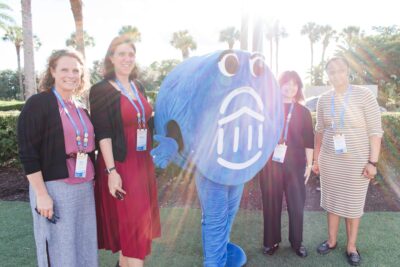Guided Pathways needs to evolve for 2025
When Guided Pathways launched in 2017, many community colleges jumped right into reforming their student success strategies. The goal was to move away from a “cafeteria” model where students could pick and choose courses without a clear pathway to their post-completion and professional goals, and instead to adopt a more intentional, guided approach to student success. In the years that followed, colleges overhauled academic advising, revamped orientation programs, and strengthened first-year experience courses. So where are we now?
Our progress on Guided Pathways so far
The good news? Recent data shows these efforts are paying off—especially for colleges that have fully implemented Guided Pathways reforms.
In one study, CCRC partnered with AACC to track 30 institutions across seven years, measuring their level of implementation and “early momentum metrics.” In that time, 37% of schools adopted Guided Pathways at scale and another 40% achieved some progress in establishing the model. Colleges that made the most progress on Guided Pathways implementation showed a positive relationship to early momentum metrics such as credit accumulation in college-level math and English.
Much has changed in higher ed and beyond since 2017, and some institutions may have lost momentum in their Guided Pathways efforts due to pandemic disruptions, personnel changes, and a heightened focus on enrollment recovery. As states and colleges revisit Guided Pathways reforms or reassess their established strategies, now is a time to pause and explore how technology can enhance these efforts, enabling you to better support your students.
What’s changed on community college campuses since 2017?
Student needs and expectations are continually evolving, but recent years have brought significantly more rapid changes that will likely require you to update existing Guided Pathways reforms to stay aligned (if you haven’t begun doing so already!). Key shifts include struggles to retain staff, the surge in demand for remote services, and the significant impact of pandemic-related learning loss and mental health concerns on both current and future students.
Here’s what’s different now compared to when Guided Pathways reform first started:
- Staffing declines and reduced capacity: Institutions are having a more difficult time hiring and retaining staff, and many staff members are reporting feeling burned out. During the 2022-23 academic year, voluntary turnover for higher ed staff was the highest it’s been since CUPA-HR started tracking it in 2017-18. This means your college may have less bandwidth to implement Guided Pathways reforms, and it’s unlikely that you will be able to hire your way out of capacity burdens.
- More students are opting out of college: Nearly a one third of 18-to-24-year-olds have never enrolled in college, despite a rise in high school graduation rates. To reach these disengaged students, the “guidance” of Guided Pathways may need to extend into high school to encourage more students to consider post-secondary options.
- Students are less prepared for college: Since the pandemic, K12 students have seen significant declines in math and reading attainment, and increases in stress, anxiety, and depression. Guided Pathways strategies need to account for students who are less prepared for college, both academically and socioemotionally. Historic Guided Pathways interventions focus heavily on academic planning, but more and more we are seeing how the impacts of stress, anxiety, and mental wellbeing can steer students off track.
- Remote services are the norm: Since the pandemic, students have developed a stronger preference for remote learning, online advising, and flexible service hours. For many, the face-to-face advising and traditional paper-and-pencil processes that some Guided Pathways initiatives are built on are less appealing. Guided Pathways strategies need to include easy ways to schedule remote appointments and engage with staff asynchronously so students don’t skip touchpoints with advisors, tutors, and faculty.
- Students are more tech centered: Teens are spending over eight hours a day on screens, and screen usage has likely increased since 2020. This means institutions need to prioritize tech-first supports that students can access from their phones. Younger students in particular are used to a highly tech-enabled high school experience and may struggle to navigate processes that aren’t “tech first”.
How can technology help your Guided Pathways reforms?
Technology can help scale efforts to meet post-pandemic student needs without adding to staff workloads. By automating repetitive tasks, creating student-friendly workflows, and consolidating student data, community colleges can work more efficiently toward their Guided Pathways goals.
Navigate360 allows institutions to centralize student information so they can better coordinate interventions, streamline communication, and engage students at scale. With student data in one place, advisors, faculty, and support staff gain a clear view of each student’s campus experience—including support contacts, appointments, and past interventions. This transparency helps keep students on track and reduces the need for them to repeat their story multiple times.
Adopting a tech-forward approach helps build your team’s Guided Pathways efficiency by:
-
- Reducing Manual Processes: Your students may be receiving manual reminders from advisors about their next steps to stay on track, taking up advisor time that could be devoted to more personalized interactions.
- Improving Data Insights: Guided Pathways need real-time data collection and analytics to effectively track student progress and outcomes.
- Scaling Interventions: Advisors are supporting hundreds of students, so scaling communications and interventions at scale is critical to making sure that students don’t fall between the cracks.
Ready to learn more about Navigate360?
Here’s how specific functions within Navigate360 support each pillar of the Guided Pathways approach:
1. Clarifying paths to student education and career goals
Student Journeys:
Journeys is a feature that helps student understand and complete essential steps toward specific student success goals, like Career Success, Financial Success, and Academic Success, and is embedded across Navigate360’s student, staff, and reporting tools. This approach provides students with clear direction for each task they need to complete, when they need to complete it, and who can help them along the way.

By clearly defining pathways using technology, institutions can ensure their students are able to anticipate next steps, reducing confusion. Journeys are customizable, so your college can clarify paths that are unique to your services, priorities, and program offerings.
2. Helping students get on a path:
Recruitment Success:
Navigate360’s Recruitment Success module combines data-driven insights with CRM capabilities, enabling personalized communication and targeted outreach to prospective students. Community colleges use this tool to connect with prospective students about career planning, program options, and how they can pay for school. By having a strong strategy to engage prospective students earlier, we can help them enter their path with confidence.

Click to learn more about how Central Virginia Community College uses Navigate360 Recruitment Success to get more students on their path.
3. Keeping students on the path:
Program Advising:
Creating a collaborative course plan that allows for building, scheduling, and registration within a single platform that decreases student confusion. This advisor-led tool streamlines administrative scheduling tasks so advisors spend less time on paperwork and have more time to build relationships with students, which is critical to keeping them on their path.

-
+2.09 average credit load
per semester for students who registered with Program Advising over those who did not.
Broward College
-
33 percentage point
higher re-enrollment rate for students who built their schedule in Navigate360 compared to those who did not.
Manchester Community College
AI-Powered Knowledge Bot:
Sometimes students have quick questions that are critical to keeping them on their path, like when registration starts, how to drop a course, or how to schedule tutoring. The Knowledge Bot provides students with instant, accurate, and secure access to institution-specific information, including support resources, instructions, and FAQs. This helps keep students on track academically by reducing the time they spend searching for accurate information and ensuring they receive fast, reliable guidance.
4. Ensure students are learning:
Early Alerts:
EAB’s early alert functionality allows faculty and staff to easily recommend students for both academic and social interventions. This helps you proactively support student success by facilitating targeted outreach and personalized support plans that can keep them on track in the classroom.

Broward College uses periodic early alerts triggered by academic performance to help students struggling in college algebra connect with advisors, tutoring, and financial aid, ensuring they receive the support needed to keep on learning. Read more about how Broward College uses Navigate360 to improve math outcomes.
Population Health, Intervention Effectiveness, and Workflow Analytics:
Curated dashboards aggregate data on student touchpoints and staff activity. This allows administrators to assess impact and identify further opportunities for outreach and intervention so they can ensure that learning is happening across all populations.

Your college likely has Guided Pathways goals aligned with different student demographics and cohorts. Utilizing technology to easily track the progress of each of your focus populations saves time and allows you to make quicker adjustments so you can ensure all students are learning.
Summary
Guided Pathways remains a powerful framework for supporting student success, but today’s post-pandemic challenges require new adjustments. By integrating technology solutions like EAB’s Navigate360, colleges can streamline complex processes, personalize outreach, and provide flexible, tech-friendly options for students. Embracing these tech-enabled strategies can help institutions address evolving student needs, support their staff, and ensure students stay on their academic path with greater ease and engagement.

More Blogs

Four signs it’s time to break up with your student CRM

Three lessons from 1,200 student success leaders on higher ed’s future

